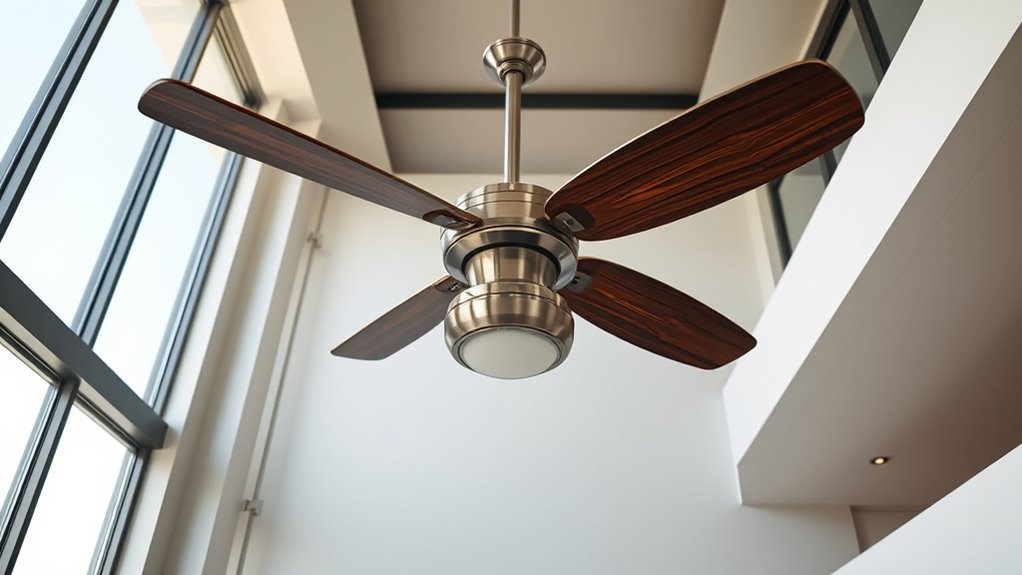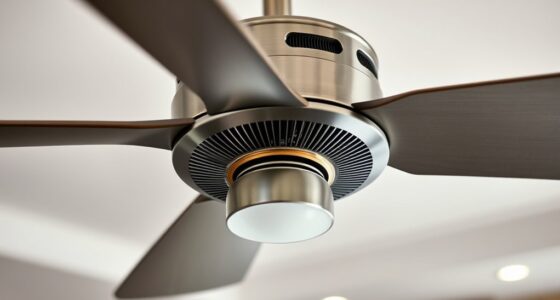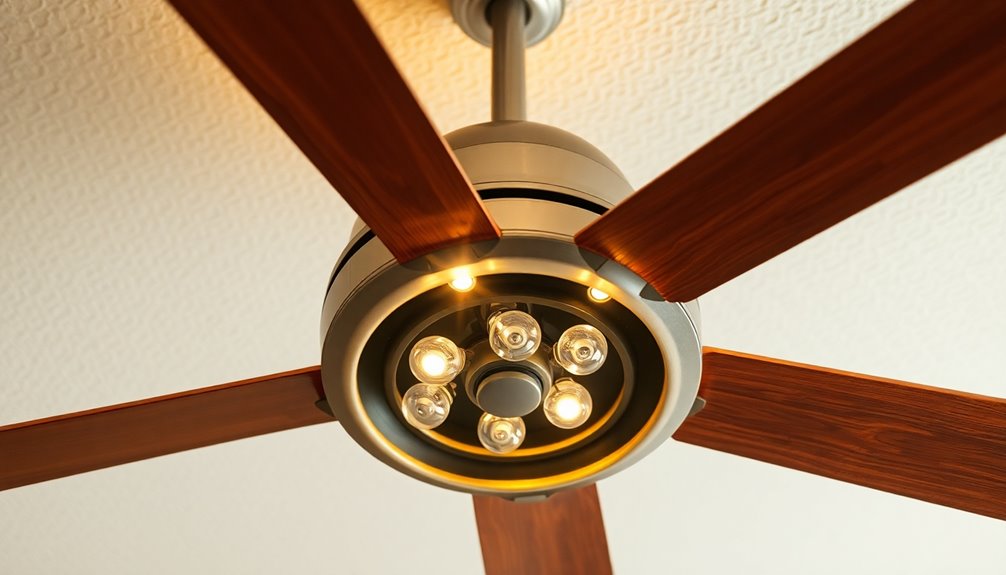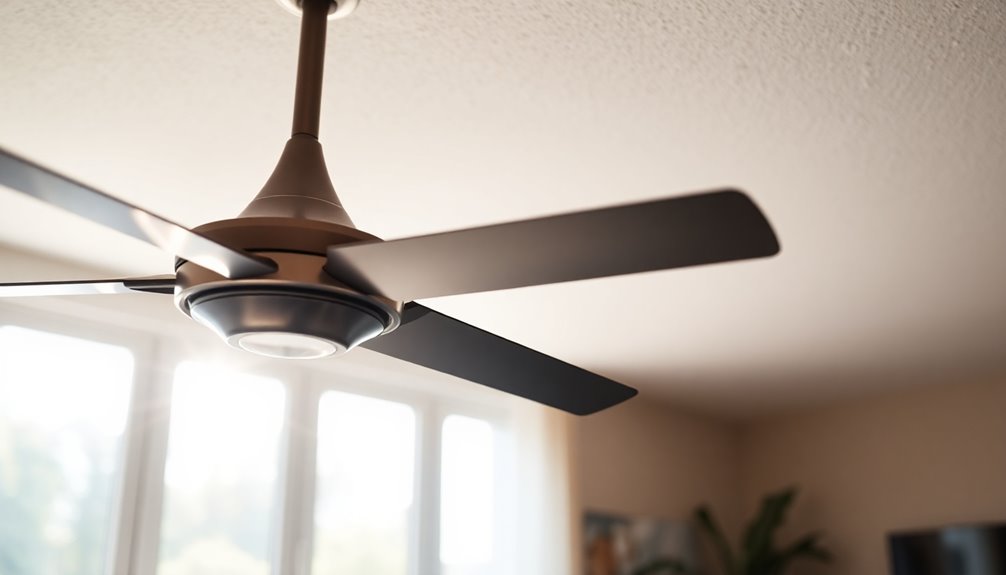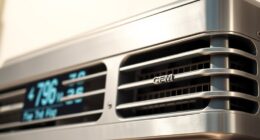To select the right ceiling fan for high ceilings, choose a fan with a blade span of 60 inches or more for better airflow, and opt for blades with a pitch of 12-15 degrees. Use longer downrods to position the fan at an ideal height, and guarantee it has a powerful motor of at least 0.75 HP. Look for models with advanced control options and lighting to enhance comfort and efficiency. Keep exploring to discover how to maximize performance and safety.
Key Takeaways
- Choose fans with large blade spans (60 inches or more) for effective airflow in high-ceiling spaces.
- Opt for fans with 12–15° blade pitch and powerful motors (0.75 HP or higher) for optimal performance.
- Use appropriate mounting options: flush mounts for ceilings under 8 ft, longer downrods for higher ceilings.
- Select fans with integrated or compatible lighting and remote or smart controls for convenience.
- Ensure proper installation to maximize safety, airflow, and energy efficiency in large or vaulted spaces.
Determining the Ideal Fan Size for High Ceilings

When choosing a ceiling fan for high ceilings, selecting the right size is essential for effective airflow and comfort. High ceilings require fans with larger blade spans, typically 60 inches or more, to ensure proper air circulation. The fan size, or fan diameter, should correspond to your room size; rooms over 400 sq ft benefit from large ceiling fans with wide blade spans. Additionally, the ceiling height influences the downrod length needed, so the blades hang approximately 8 to 10 feet above the floor for ideal performance. Properly sized fans help maximize airflow, keeping the space comfortable. Larger fans with appropriate blade span and diameter are more efficient in high-ceiling environments, providing better air movement and temperature regulation. Moreover, blade pitch also plays a role in airflow efficiency, especially in spaces with high ceilings. Selecting a fan with an optimal motor size ensures sufficient power to circulate air effectively in larger spaces. Considering the aesthetic style of the space can also help in selecting a fan that complements your farmhouse or rustic decor.
Choosing the Right Mounting Options and Downrod Lengths

Choosing the right mounting options and downrod lengths guarantees your ceiling fan functions smoothly and looks good in your space. For ceilings over 8 feet, a longer downrod positions blades 2.4 to 3 meters above the floor, optimizing airflow. Use flush mounts for ceilings under 8 feet, but opt for longer downrods for vaulted or high ceilings exceeding 10 feet. Adjustable brackets and sloped ceiling kits are essential for angled or vaulted ceilings, ensuring proper blade alignment and safety. Proper selection reduces fan wobbling, maintains balance, and enhances overall fan installation. Additionally, considering ceiling fan safety, such as secure mounting and appropriate clearances, is essential for optimal performance and longevity. Proper measurement and understanding of relationship dynamics can prevent installation errors and ensure the fan’s efficiency and safety. Here’s a quick guide:
| Ceiling Height | Recommended Downrod Length | Mounting Options |
|---|---|---|
| Under 8 ft | Flush mount | Standard mounting |
| 8–10 ft | 30–60 cm | Adjustable brackets |
| Over 10 ft | 60+ cm | Sloped ceiling kits, angle mounting |
Selecting Fans With Suitable Motor Power and Blade Designs

When choosing a ceiling fan, you need to consider the motor’s power to guarantee it can move enough air for your space.
Blade design also plays a vital role in maximizing airflow efficiency, especially when combined with the motor’s strength.
Selecting the right balance between motor power and blade shape guarantees effective circulation and long-lasting performance.
Motor Power Requirements
How do you guarantee your ceiling fan has enough power to circulate air effectively in your space? Focus on selecting a fan motor with sufficient motor horsepower, typically 0.75 HP or higher, to handle large areas and high ceilings.
High ceiling fans require a powerful fan motor capable of generating ample airflow, measured in CFM, to ensure effective circulation. Look for fans with larger blade spans and a blade pitch of 12-15 degrees, which demand greater motor capacity to perform at its best. An energy-efficient motor, like one with DC technology, offers strong airflow while consuming less power. Reversible motors with multiple speeds provide flexibility for seasonal airflow adjustments. Additionally, choosing a motor with strong leadership skills can help ensure optimal performance and maintenance of the fan over time. Incorporating proper installation techniques can further enhance the motor’s efficiency and longevity, especially in spaces with high ceilings where airflow dynamics are more challenging. Properly balanced blades and advanced motor control systems also contribute to quieter operation and improved efficiency. To optimize performance, consider selecting fans with aesthetic hooks and wall organization stylish solutions that can help in managing space and airflow pathways effectively.
Blade Design Efficiency
Ever wondered why some ceiling fans move air more effectively than others? It all comes down to blade design efficiency. Fans with larger blade spans, like those over 60 inches, need more motor power to deliver proper airflow in high-ceiling spaces.
The key is selecting blades with the right pitch—typically between 12° and 15°—which maximizes airflow efficiency by optimizing air movement per rotation. Aerodynamic blades with streamlined shapes and good blade materials, such as wood or composites, further improve energy efficiency and reduce motor strain.
Reversible blades with aerodynamic designs cut noise and drag, enhancing overall fan performance. When choosing a fan, focus on blade span, blade shape, and pitch to ensure your fan delivers effective airflow while conserving energy. Proper blade design efficiency can significantly impact the fan’s performance and longevity.
Ensuring Proper Installation and Safety Measures
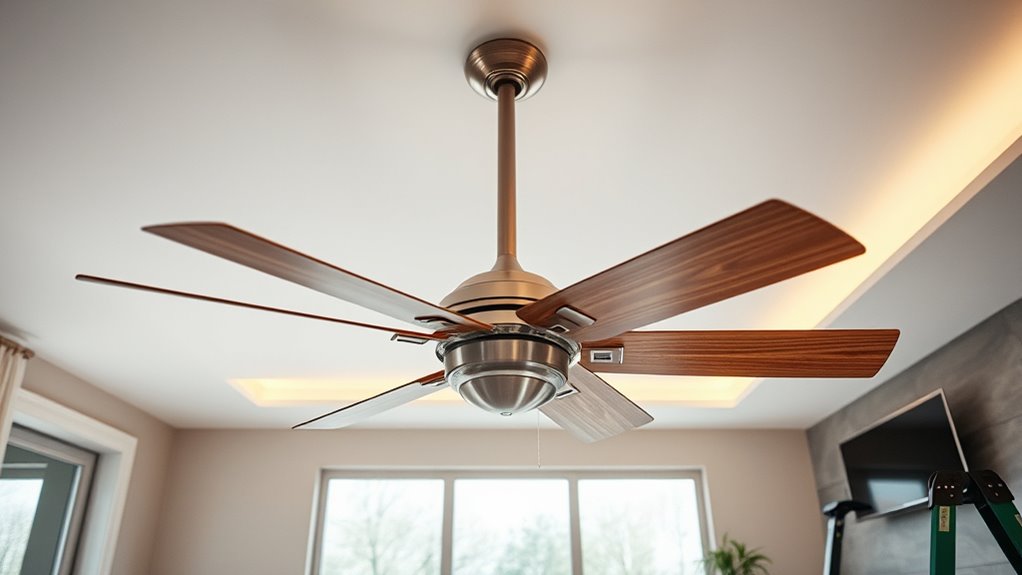
To guarantee your ceiling fan is installed safely and functions properly, you need to pay close attention to securing it correctly and following proper procedures. Measure the ceiling height carefully to choose the right downrod length—typically 30-60 cm for ceilings over 3 meters. Use slope ceiling kits and adjustable brackets to ensure the fan hangs straight on angled ceilings. Securely fasten the fan to a ceiling joist or support brace to prevent wobbling. Follow electrical codes and manufacturer instructions for proper wiring and grounding. For high ceilings, professional installation is recommended to meet safety standards and ensure proper mounting. Proper filtration systems can also help maintain indoor air quality and prolong the fan’s lifespan. Additionally, understanding AI-powered tools can assist in planning and optimizing your installation process for better safety and efficiency. Employing safety equipment during installation is essential to protect yourself and ensure a secure setup. Here’s a quick overview:
| Support & Mounting | Electrical Safety | Installation Quality |
|---|---|---|
| Support brace, ceiling joist | Proper wiring, grounding | Secure fastening, balance |
Incorporating Lighting and Control Features for Large Spaces

To effectively light large spaces, choose ceiling fans with integrated LED kits or compatible fixtures that provide bright, widespread illumination. You can also opt for fans with multiple bulbs or multi-arm light kits to enhance coverage, and consider dimmable options to adjust ambiance easily. Make sure your control system—whether remote, smart, or manual—is compatible with your home setup for seamless operation. Incorporating lighting options such as diffusers or aromatherapy features can also contribute to creating a comfortable and inviting environment in large spaces. Additionally, selecting fans with jet boat-inspired designs can add a unique aesthetic element to your decor. For optimal air circulation and comfort, consider fans with high airflow capacity, especially in spaces with high ceilings. Properly selecting high ceiling fans with lighting ensures effective coverage and enhances the room’s overall ambiance. Choosing fans with appropriate size and blade span is crucial to ensure proper airflow and avoid overwhelming the space.
Lighting Options and Placement
Thinking about lighting in large spaces, integrating ceiling fans with LED light kits offers an efficient way to illuminate your area while saving energy. Proper light fixture placement guarantees even distribution, reducing shadows and highlighting your space’s features.
Choose fans with integrated LED and dimmable lighting to adjust light brightness for different activities or moods. Multi-bulb kits or multi-arm light fixtures increase ambient lighting, especially in rooms with high ceilings. Additionally, selecting fans with lighting control features such as remote or smart options allows you to customize illumination easily. Position fans correctly to optimize airflow and lighting coverage. Incorporating personality insights can help you select styles and features that match your personal or organizational aesthetic, ensuring a cohesive space. This combination provides energy-efficient illumination while enhancing the room’s aesthetic and functionality.
Control System Preferences
Ever consider how control options can enhance your large space’s comfort and convenience? Choosing the right system makes a big difference. Remote controls and wall controls are perfect for high ceilings, letting you adjust fan speed and lighting easily without ladders. Smart control systems with Wi-Fi connectivity enable you to operate fans via smartphone apps, customizing settings like lighting and automation. Fans with dimmable LED lights add versatility, creating the perfect ambiance. To optimize functionality, select options that combine fan speed, lighting adjustments, and voice commands.
| Control Feature | Benefit |
|---|---|
| Remote & Wall Controls | Easy access, no ladders needed |
| Smartphone Apps | Customization, automation, convenience |
| Voice Commands | Hands-free operation |
| Dimmable LED Lights | Adjustable illumination for ambiance |
Tips for Maximizing Airflow and Energy Efficiency

Maximizing airflow and energy efficiency with your ceiling fan involves selecting the right size and features. For high ceilings, choose fans with higher CFM ratings—7,000 to 10,000+—to ensure effective airflow.
Opt for larger blade spans of 60 inches or more to cover wide areas and promote ideal circulation. Proper downrod length positions the fan at the optimal height of 2.4-3 meters above the floor, enhancing efficiency.
Look for fans with high-quality motors and reversible blades to boost airflow while reducing energy consumption. Using remote controls or smart systems allows easy adjustments of speed and direction, maintaining energy efficiency without climbing.
Focus on these key factors to maximize airflow and keep energy costs low in high-ceiling spaces.
Frequently Asked Questions
How to Choose a Ceiling Fan for a High Ceiling?
When choosing a ceiling fan for a high ceiling, you need a larger blade span, usually 52 inches or more, to circulate air effectively.
Use a longer downrod to position the fan at the right height, around 2.4 to 3 meters above the floor.
Pick a fan with a powerful motor and high CFM rating, and consider smart controls for easy operation from below.
Guarantee the mounting system suits your ceiling pitch for safety and performance.
What Height Should a Fan Be for a Tall Ceiling?
When considering the height of a fan for a tall ceiling, you want the blades to hang about 2.4 to 3 meters (8 to 10 feet) above the floor.
If your ceiling is over 3 meters, use a longer downrod—at least 30 centimeters (12 inches)—to position the fan correctly.
For ceilings over 4.3 meters, opt for even longer downrods of 60 centimeters (24 inches) or more.
Are Ceiling Fans Effective With High Ceilings?
Imagine a gentle breeze sweeping through a mountain summit—that’s how effective ceiling fans can be with high ceilings. When properly chosen and installed, they circulate air efficiently, making your space comfortable year-round.
You need fans with large blades, powerful motors, and the right downrods to reach high above. With the correct setup, your high-ceiling room transforms into a cool, breezy haven, no matter how tall the space is.
What Is the Rule of Thumb for Ceiling Fans?
The rule of thumb for ceiling fans is to pick one with a blade span roughly one-third to one-half of your room’s width for ideal airflow.
For larger rooms over 18 feet, go for fans with at least a 56-inch blade span.
Make sure the blades hang about 2.4 to 3 meters above the floor, and use a downrod if your ceiling is high, to keep the fan functioning efficiently.
Conclusion
Choosing the right ceiling fan for high ceilings guarantees ideal airflow and comfort. For instance, installing a fan with a longer downrod and powerful motor can make a big difference in a large living room. Imagine a homeowner who upgraded to a high-capacity fan; not only did it cool the space more effectively, but it also reduced energy costs. Always prioritize safety, proper sizing, and features to create a comfortable, energy-efficient environment.
